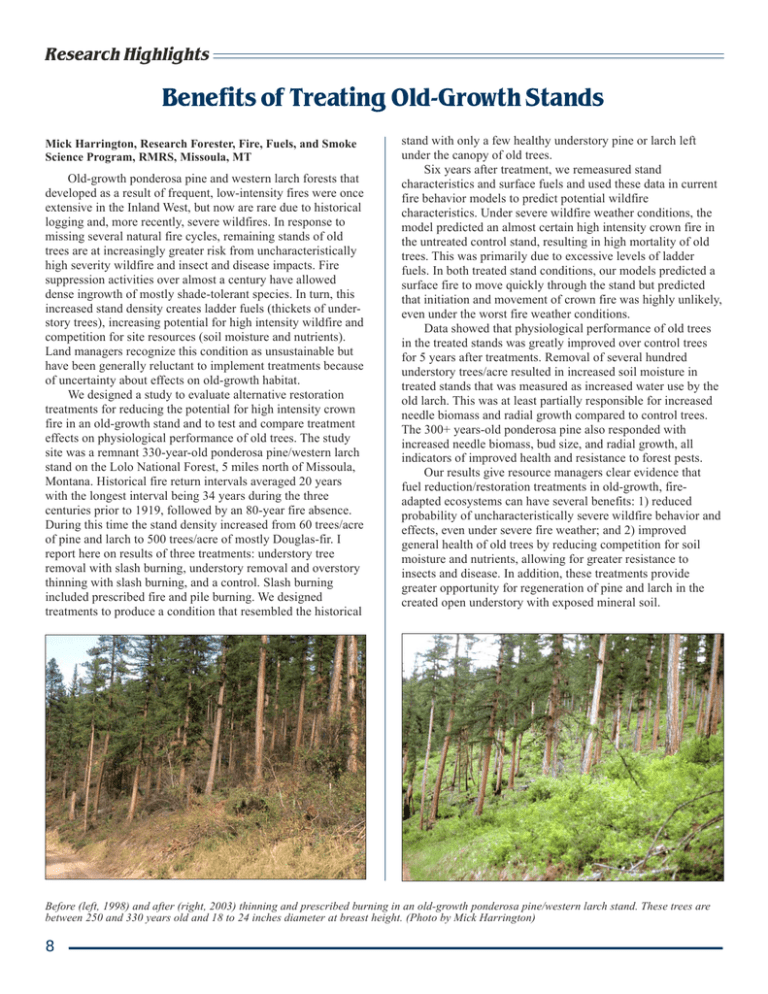Benefits of Treating Old-Growth Stands Research Highlights
advertisement

Research Highlights Benefits of Treating Old-Growth Stands Mick Harrington, Research Forester, Fire, Fuels, and Smoke Science Program, RMRS, Missoula, MT Old-growth ponderosa pine and western larch forests that developed as a result of frequent, low-intensity fires were once extensive in the Inland West, but now are rare due to historical logging and, more recently, severe wildfires. In response to missing several natural fire cycles, remaining stands of old trees are at increasingly greater risk from uncharacteristically high severity wildfire and insect and disease impacts. Fire suppression activities over almost a century have allowed dense ingrowth of mostly shade-tolerant species. In turn, this increased stand density creates ladder fuels (thickets of understory trees), increasing potential for high intensity wildfire and competition for site resources (soil moisture and nutrients). Land managers recognize this condition as unsustainable but have been generally reluctant to implement treatments because of uncertainty about effects on old-growth habitat. We designed a study to evaluate alternative restoration treatments for reducing the potential for high intensity crown fire in an old-growth stand and to test and compare treatment effects on physiological performance of old trees. The study site was a remnant 330-year-old ponderosa pine/western larch stand on the Lolo National Forest, 5 miles north of Missoula, Montana. Historical fire return intervals averaged 20 years with the longest interval being 34 years during the three centuries prior to 1919, followed by an 80-year fire absence. During this time the stand density increased from 60 trees/acre of pine and larch to 500 trees/acre of mostly Douglas-fir. I report here on results of three treatments: understory tree removal with slash burning, understory removal and overstory thinning with slash burning, and a control. Slash burning included prescribed fire and pile burning. We designed treatments to produce a condition that resembled the historical stand with only a few healthy understory pine or larch left under the canopy of old trees. Six years after treatment, we remeasured stand characteristics and surface fuels and used these data in current fire behavior models to predict potential wildfire characteristics. Under severe wildfire weather conditions, the model predicted an almost certain high intensity crown fire in the untreated control stand, resulting in high mortality of old trees. This was primarily due to excessive levels of ladder fuels. In both treated stand conditions, our models predicted a surface fire to move quickly through the stand but predicted that initiation and movement of crown fire was highly unlikely, even under the worst fire weather conditions. Data showed that physiological performance of old trees in the treated stands was greatly improved over control trees for 5 years after treatments. Removal of several hundred understory trees/acre resulted in increased soil moisture in treated stands that was measured as increased water use by the old larch. This was at least partially responsible for increased needle biomass and radial growth compared to control trees. The 300+ years-old ponderosa pine also responded with increased needle biomass, bud size, and radial growth, all indicators of improved health and resistance to forest pests. Our results give resource managers clear evidence that fuel reduction/restoration treatments in old-growth, fireadapted ecosystems can have several benefits: 1) reduced probability of uncharacteristically severe wildfire behavior and effects, even under severe fire weather; and 2) improved general health of old trees by reducing competition for soil moisture and nutrients, allowing for greater resistance to insects and disease. In addition, these treatments provide greater opportunity for regeneration of pine and larch in the created open understory with exposed mineral soil. Before (left, 1998) and after (right, 2003) thinning and prescribed burning in an old-growth ponderosa pine/western larch stand. These trees are between 250 and 330 years old and 18 to 24 inches diameter at breast height. (Photo by Mick Harrington) 8


